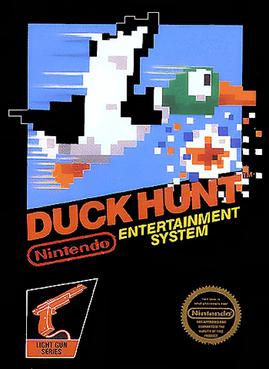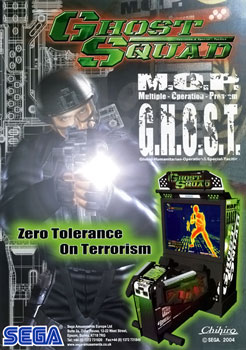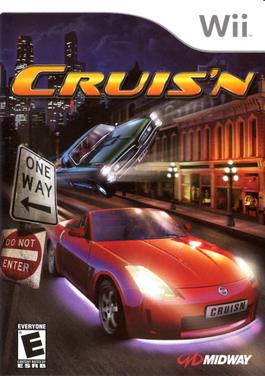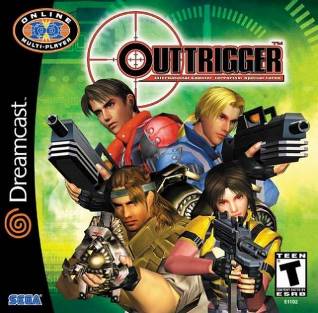
Duck Hunt is a 1984 light gun shooter video game developed and published by Nintendo for the Nintendo Entertainment System (NES) video game console and the Nintendo VS. System arcade hardware. The game was first released in April 1984, in Japan for the Family Computer (Famicom) console and in North America as an arcade game. It became a launch game for the NES in North America in October 1985, and was re-released in Europe two years later.
Shoot 'em ups are a sub-genre of action games. There is no consensus as to which design elements compose a shoot 'em up; some restrict the definition to games featuring spacecraft and certain types of character movement, while others allow a broader definition including characters on foot and a variety of perspectives.

Xevious is a vertically scrolling shooter arcade video game developed and published by Namco in 1982. It was released in Japan by Namco and in North America by Atari, Inc. Controlling the Solvalou starship, the player attacks Xevious forces before they destroy all of mankind. The Solvalou has two weapons at its disposal: a zapper to destroy flying craft, and a blaster to bomb ground installations and enemies. It runs on the Namco Galaga arcade system.

Robotron: 2084 is a multidirectional shooter developed by Eugene Jarvis and Larry DeMar of Vid Kidz and released in arcades by Williams Electronics in 1982. The game is set in the year 2084 in a fictional world where robots have turned against humans in a cybernetic revolt. The aim is to defeat endless waves of robots, rescue surviving humans, and earn as many points as possible.

Eugene Peyton Jarvis is an American game designer and video game programmer, known for producing pinball machines for Williams Electronics and video games for Atari. Most notable among his works are the seminal arcade video games Defender and Robotron: 2084 in the early 1980s, and the Cruis'n series of driving games for Midway Games in the 1990s. He co-founded Vid Kidz in the early 1980s and currently leads his own development studio, Raw Thrills Inc. In 2008, Eugene Jarvis was named the first Game Designer in Residence by DePaul University's Game Development program. His family owns the Jarvis Wines company in Napa, California.

Cruis'n USA is an arcade racing game originally released in 1994. It was developed by Eugene Jarvis' company TV Games Inc., and manufactured by Midway Games. It is the first game in the Cruis'n series and features races set in locations across the continental United States.

Silent Scope is an arcade game created in 1999 by Konami. The game puts the player in the shoes of a sniper during a series of terrorist incidents. It is the first in the Silent Scope series.

Smash TV is a 1990 arcade video game created by Eugene Jarvis and Mark Turmell for Williams Electronics Games. It is a twin-stick shooter in the same vein as 1982's Robotron: 2084, which was also co-created by Jarvis. The Super Nintendo Entertainment System, Genesis, Master System, and Game Gear versions are titled Super Smash TV.

Raw Thrills, Inc. is an arcade video game entertainment company based in Skokie, Illinois. It is best known for developing arcade games based on films.

Radirgy is a shoot 'em up video game developed by MileStone Inc. and released for the Sega NAOMI arcade platform in 2005. The story follows schoolgirl Shizuru Kamigusa in an age filled with radio waves which she is allergic to. She must save her father, who is developing a remedy for her sickness, from terrorists who have taken control of his company. The game features bullet hell gameplay elements and a distinct cel shaded graphical style.

Time Crisis 4 is a rail shooter and the fourth installment in the main series. It was released as an arcade game in 2006, and was ported with the GunCon 3 light gun peripheral for PlayStation 3 in 2007. It features a new first-person shooter mode. It was later re-released as part of Time Crisis: Razing Storm with support for the PlayStation Move controller, without the first-person shooter mode.

Blazing Angels: Squadrons of WWII is a flight combat video game for Microsoft Windows, Xbox, Xbox 360, PlayStation 3 and Wii. It was developed by Ubisoft Bucharest during the second fiscal quarter of 2006 for both the North American and European regions. The game features 46 different World War II fighter planes and allows the player or players to take part in several World War II events as a fictional squadron. Online support allows 16 players to take part in head-to-head and co-operative battles.

Ghost Squad and Ghost Squad: Evolution are light gun rail shooter arcade games developed and published by Sega. A home version of the original Ghost Squad was developed for Nintendo's Wii game console. A sequel, Operation GHOST, was released in arcades in 2012.

Maximum Force is a light gun shooter arcade game developed by Mesa Logic for Atari Games in 1997. In 1998, Atari Games re-released the game as part of one machine called Area 51/Maximum Force Duo that also included Area 51, and later ported the game to both the Sony PlayStation and Sega Saturn game consoles.

Cruis'n is a series of racing video games originally developed by Eugene Jarvis for Midway Games and published by Midway and Nintendo. The series distinguishes itself from other racing games with its over-the-top presentation and fast-paced gameplay, featuring a wide variety of vehicles and tracks based on a variety of real world locations. The series debuted in North American and European arcades in 1994 with the release of Cruis'n USA, which, along with Killer Instinct, was advertised as running on Nintendo's Ultra 64 hardware. Two sequels followed, Cruis'n World and Cruis'n Exotica, which featured new vehicles and tracks. All three games were released for the Nintendo 64 as well, with Exotica also being released for the handheld Game Boy Color. The next game in the series, Cruis'n Velocity deviated from the traditional arcade gameplay of the series and was released for the Game Boy Advance.

Cruis'n is a racing game for the Wii released in 2007. It was originally released as The Fast and the Furious in arcades in 2004, based on the Fast & Furious franchise and developed by and published by Raw Thrills. The Wii version was ported by Just Games Interactive and published by Midway.

Outtrigger is a first/third-person shooter video game developed by Sega AM2 for the Sega NAOMI arcade cabinet and the Dreamcast. The game was originally released in 1999 for the arcades and was later ported over to the Dreamcast in 2001. The player character of Outtrigger is a member of an anti-terrorist group, and can be chosen between default characters with different specialties or a custom character, and can utilize a number of power-ups. Reception to Outtrigger was generally positive, praising the gameplay and mechanics, though criticizing the removal of online play in the European version of the game.
Light-gun shooter, also called light-gun game or simply gun game, is a shooter video game genre in which the primary design element is to simulate a shooting gallery by having the player aiming and discharging a gun-shaped controller at a screen. Light-gun shooters revolve around the protagonist shooting virtual targets, either antagonists or inanimate objects, and generally feature action or horror themes and some may employ a humorous, parodic treatment of these conventions. These games typically feature "on-rails" movement, which gives the player control only over aiming; the protagonist's other movements are determined by the game. Games featuring this device are sometimes termed "rail shooters", though this term is also applied to games of other genres in which "on-rails" movement is a feature. Some, particularly later, games give the player greater control over movement and in still others the protagonist does not move at all. On home computer conversions of light-gun shooters, mouse has been often an optional or non-optional replacement for a light gun.

Nex Machina is a shoot 'em up video game developed and published by Housemarque. The game was released in June 2017 for the PlayStation 4 and Windows-based personal computers. Tentatively known as The Jarvis Project during development, veteran arcade game designer Eugene Jarvis served as a creative consultant on the project.
















